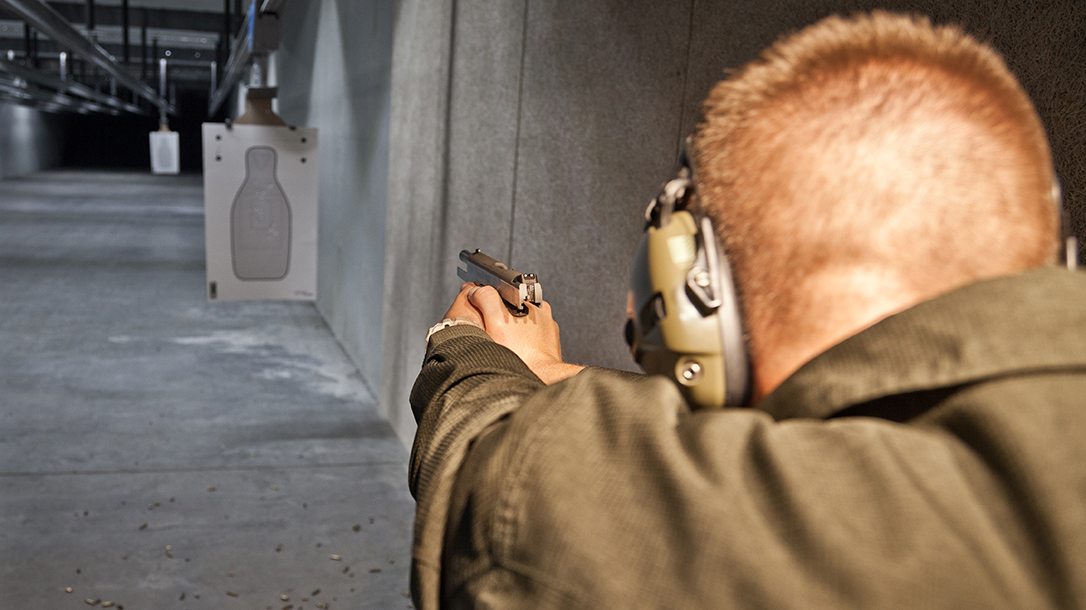Shooters train to be able to fend off deadly attacks. The most common method many work on toward this goal is the double-tap. However, they should consider adding the failure drill to their regimen.
The failure drill is basically a double-tap that doesn’t stop the attack. So, the defender takes more careful aim and fires a shot to the assailant’s head. This effectively ends the attack by immediately shutting down the nervous system. The need for this drill can be the attacker wearing body armor, being strung out on a drug or simply motivated to end your life.
History of the Failure Drill
The failure drill came out of the Mozambican War for Independence, which ran from 1964 to 1973. Mike Rousseau was a mercenary fighting in the war when he came across a guerrilla with an AK-47 at the airport. As is standard then and now, he raised his pistol and put two rounds into the guerilla’s chest. Unfortunately, this didn’t stop the man. So, Rousseau fired a shot at the head. The story goes that Rousseau was using a Browning Hi-Point 9mm and missed the head shot, actually hitting the rebel in the neck. This shot, however, severed the spinal cord and put him down. Rousseau’s tactical concept, however, was sound. And he did this under the stress of a gunfight.
Advertisement — Continue Reading Below
The legend continues in that Rousseau eventually conveyed this story to Col. Jeff Cooper, who turned it into the Mozambique drill as part of the Modern Pistol Technique taught at Gunsite Academy. Later, the name changed as other training schools implemented it into programs. Some say this was because of the concern of racial overtones by Las Angeles officers. Of course, firing a third shot when the first two shots failed also makes sense.
Performing the Failure Drill
Now that we understand the concept and history, it’s time to actually learn how to perform the failure drill.
For this drill, you will need a silhouette target, or something similar, set between 5 and 7 yards and a handgun in the low-ready position. A shot timer is also an excellent tool, but not required. Either at a command or the beep, raise the gun and fire two shots into the center mass of the target. Then, assess the situation, determine the attacker has not stopped and fire a third round at the head of the silhouette.
Advertisement — Continue Reading Below
Now, whether called a double-tap, a hammer or something else, the two shots should be within an 8-inch circle in the center of the target. Then, and this is crucial, you should assess the situation before firing the third shot. This shot should hit between the eyebrows and lips for the best possible results. And all this should be performed in around 4 seconds.
The assessment is very important. This drill is not about seeing how fast you can put two rounds in center mass and another at the head. This drill simulates an attack, where the shooter defends with two controlled shots to stop the attacker. When this doesn’t work, another round is sent at the head to immediately stop the attacker.
Consider These Adjustments
While this is a great drill there are several adjustments shooters can use to make it more challenging and realistic. The first is starting from retention rather than low-ready, particularly retention from concealment. If you end up in a situation, your gun is probably going to be in the holster under your shirt.
Advertisement — Continue Reading Below
The second adds in movement. If someone attacks, you are probably not going to stand like you’re on a firing line to draw and fire. You are much more likely to sidestep or retreat to increase the distance between you and the attack. So, it only makes sense to add some movement to the drill, if your range allows this.
Finally, to add realism, have a partner who decides whether the third shot is needed. The shooter draws and fires two shots into the body, then, the partner announces whether the target is down or still attacking. This completely adds the assessment factor into the drill. Sure, this may not seem to be that important, but you will fight how you train. If you put two in the body and one in the head every time in training, then you will do the same on the street. And if the two shots to the body stopped the attack, you could face serious issues if you put one in the head.
























